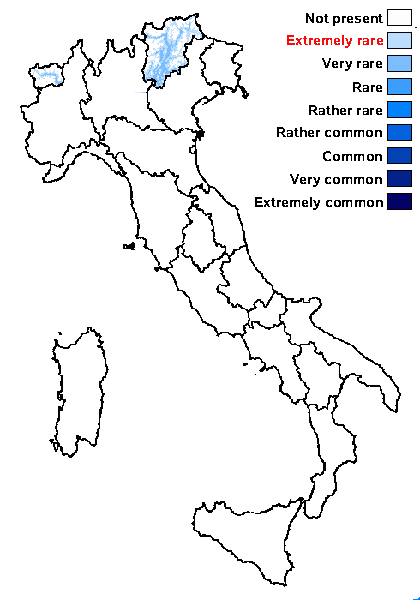Rinodina polysporoides Giralt & H. Mayrhofer
Herzogia, 10: 33, 1994.
Synonyms:
Distribution: N - TAA (Arnold Lich. Exs. 1654 p.p.: Giralt & Mayrhofer 1994, Nascimbene & al. 2007b), VA (Piervittori & Maffei 1996, 2001, Piervittori & Isocrono 1999).
Description: Thallus crustose, episubstratic, thin, discontinuous, smooth to finely verrucose, rimose-areolate, grey, dark grey or greyish-green, without a distinct prothallus. Apothecia lecanorine, usually scattered to confluent, broadly attached, 0.2-0.4 mm across, with a persistently flat, dark brown to black disc, and a rather thick entire to flexuose, rarely finally excluded thalline margin. Thalline exciple 40-70 µm wide laterally, corticate, the cortex 10-20 µm thick in lower part, I+ faint blue; proper exciple 5-10 µm wide laterally, expanded to 20-30 µm in upper part; epithecium dark brown; hymenium colourless, 60-80 µm high; paraphyses 1.5-2 µm thick at base, the apices 3-4 µm wide; hypothecium colourless, 40-80 µm high. Asci 16-spored, clavate, the K/I+ blue tholus penetrated by a faintly amyloid apical cushion with parallel or diverging flanks, the wall K/I-, surrounded by a K/I+ blue outer layer, Lecanora-type. Ascospores 1-septate, brown, ellipsoid, 10-18 x 6-9 µm, swollen around the septum after treatment with K, with a warted wall at maturity, Dirinaria-type, with ontogeny of type B (apical thickenings visible before the insertion of the septum). Photobiont chlorococcoid. Spot tests: K-, C-, KC-, P-, UV-. Chemistry: without lichen substances.Note: a temperate species found on smooth bark of trunks and branches of deciduous, more rarely of evergreen broad-leaved trees, especially on Juglans and Fraxinus, but also on Quercus; certainly more widespread. It is included in the Italian red list of epiphytic lichens as “Endangered” (Nascimbene & al. 2013c).
Growth form: Crustose
Substrata: bark
Photobiont: green algae other than Trentepohlia
Reproductive strategy: mainly sexual
Commonnes-rarity: (info)
Alpine belt: absent
Subalpine belt: absent
Oromediterranean belt: absent
Montane belt: extremely rare
Submediterranean belt: very rare
Padanian area: absent
Humid submediterranean belt: absent
Humid mediterranean belt: absent
Dry mediterranean belt: absent

Predictive model
Herbarium samples
Growth form: Crustose
Substrata: bark
Photobiont: green algae other than Trentepohlia
Reproductive strategy: mainly sexual
Commonnes-rarity: (info)
Alpine belt: absent
Subalpine belt: absent
Oromediterranean belt: absent
Montane belt: extremely rare
Submediterranean belt: very rare
Padanian area: absent
Humid submediterranean belt: absent
Humid mediterranean belt: absent
Dry mediterranean belt: absent

Predictive model
| Herbarium samples |
 Index Fungorum
Index Fungorum
 GBIF
GBIF

